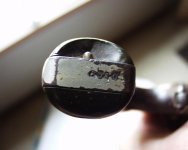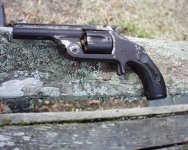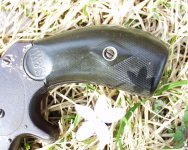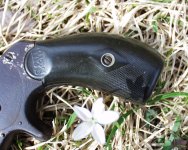Page 20 SCSW 3rd goes into a bit of detail on the top-break stocks.
"Most hard rubber stocks had molded checkering with the familiar intertwined S&W logo in the stock circle at the top of the panels. Some exceptions were the early .32 centerfire single action stocks which first had no logo, followed by a block letter, and finally the intertwined S&W logo. Another exception was the Baby Russian, whose stocks had a block letter S&W logo in the stock circles.
Red mottled stocks may also be found on all frame sizes produced in the era from about 1879 to about 1882. Blue and green mottled variations have been reported."
Page 76 on .32 frame 1 1/2 later model:
" and reissue July 25, 1871 have been observed c.1878-1892".
Page 80-81 shows 1st model/Baby Russian SN range 1-25548 c. 1876-1877.
Anywho, this 3 1/4" .38 could've come w/green stocks and being produced the following year after the Baby Russian it's no great leap to believe, if nothing else, that the Block letter S&W. stocks could be time period appropriate. I wasn't around and am not sure if counterfeit block style stocks were produced in a dull/dark green.
The reissue pat'd date on the top of the barrel coincides w/that noted on the .32 albeit this .38 should be first year 1877. One hundred and thirty-seven years presents plenty of opportunities to exchange parts.
Yet, the latch, frame and at least the first three of four serial numbers on cylinder face, 605, matching could suggest that the ole gal is in original trim. The time frame of these worn smooth molded checkered diamond stocks are an unknown variable to me. I don't have a clue. On the inside of the left panel there appears to be a pencil written '2'. Granted that's looking through the loupe w/light hitting it just right along w/attempting to make something legible out of what little is there. Take that interpretation w/grain of salt. Only thing under the right side is apparent file/grind marks on the top and bottom as if they were high and needed to be taken down a mite to fit snugly.
Last tidbit is also on page 80. The lone picture of a 1st model Baby Russian, a second model and a third model. Look at the bottom of the stocks on the first model. There is a gentle curve w/o checkering. This is a quite different pattern than those on the 2nd model. Yet, both are of S&W. block style. The first model type shown are the same as mine though I can't tell if the pair in the picture are green. Here's two more pics of the left side at differing shutter speed in an attempt to highlight the dark olive green colour that isn't mottled.
As always I'm all ears for other opinions. I know little about S&W and nothing about stocks. Except that these will interchange w/my MOP off of model 1903 .32. There's a small "ridge" of back strap exposed on the 1903 running the length of the stock and the bottom of the top break stocks are beveled from the start where the MOP starts flush and then rounds up.
Also the grip pin is slightly larger in diameter on the 1903. The top break would slide on, upside down, only half way and I didn't wish to push the issue on the good stock. Not surprisingly the chipped stock slid right on. Perhaps I've uncovered the true story behind the right side missing chip. The stock screws threads are not interchangeable though they are close and the 1903 is longer w/more threads as well. Assuming both of the screws are original.
I'm at the end of the road. I'm looking at a pair of hard rubber, I'm guessing, olive green molded checkering w/diamond, brass escutcheon stocks that have the block type 'S&W.' inside the circle, yet they aren't mottled.
ETA: They're as well worn as the 32 SA. Checkering is barely visible and the bottom ridge of the circle on the left hand stock is worn smooth. The right side still displays a full circle ridge. I've looked at pictures from other SA, mostly Baby Russian, and the block type/ampersand/skinny last line of the W all the way down to the period at the end of it looks the same.
I'm just not finding anything on olive green. Do you think perhaps that these have been coated w/something? The outside is smooth & shiny though the inside is dull except for where the grip frame has come into contact. There's nothing on the inside of the right hand stock. Would you suggest washing it w/toothbrush and dish-washing liquid to see if appears green though dull? I'm guessing that the inside of the stock would be the last clue unto hue.
ETA II: Even lightly running my fingernail across the inside of the stock will leave a line. The alleged possible number then is quite a stretch and probably nothing more than a collection of scratches. No shortage of dust/lint/accumulated oxidation from the frame.
I bought this for 50 clams several years ago as an inexpensive example of a top beak SA. I remember the circumstances and being somewhat disappointed that a chip was missing from the butt of one stock. They still though well worn looked better than the condition of the little pistola.
I've also just noticed ridges running sort of perpendicular w/medallion circle only, naturally at the top half/180* of the circle. These hash marks are only visible on the small section that's left exposed from the frame. They're also on a diagonal slant and at the top of the ampersand the slant flops changing direction as a mirrored effect. Peculiar to me as well as obviously intentional. The unaided eye would just about have to know that they were there to see them, yet the loupe pulls out the detail very nicely. Being so close to the frame w/o butting up to the frame has preserved this curious feature. With limited resolution allowed pics on this forum I'm not sure even w/stacked macro lenses that I could pull out enough detail to show these alternating hash marks.
Surely by now I've exhausted all clues. I predict by 233 views I'll have my answer.[only 69 to go!]
Pg.80- Picture of the 1st model Baby Russian shows it also has strain screw on front strap though I've no clue what the SN is on pictured gun or range when started. As I understand, discounting my barrel w/o legible SN, my .38 SA frame SN 6050 could only be a Number Two 1st or second issue. I'm sure that a SN check of when the 1st issue/1st model/Baby Russian became equipped w/strain screw on inside frame strap could substantiate whether the possibility exists. Nevertheless a single action top break w/o separate rounded trigger guard in .38 w/frame extension on both sides protecting spur trigger in a round butt has to be either the first or second model. Were my SN > than 25548 then I could eliminate the possibility of a 1st model having a barrel swap. However, I'll wager that the strain screw on the front strap combined w/6050 indeed will show this to be a model two. As well since mine has the two screw sideplate if the 1st model first production run exceeded 6050 then that also would eliminate the possibility of anything other than the Model 2/2nd issue.
Now, what does this have to do w/Baby Russian block style S&W. dark green stocks? It could perhaps validate a time frame when this style of stock was available. Since 108,255 .38 SA 2nd Mod/Mod 2 2nd issue were manufactured c. 1877-1891 it is conceivable that early Mod 2/2nd issue could have been available w/same Baby Russian style stocks as carryovers from the first/only year 1876 run of the 1st mod/mod #2 1st mod.
Interestingly enough, or not dependent on final conclusion, I come back to that picture on pg. 80. The second model pictured has the other style, circled S&W monogram & middle of butt "point" to the inside diamond, stocks. Also appears that the small ridge of exposed back strap is more prominent on the second model. I'll guess that this is also due to the construction of the second model stocks. Or perhaps the first model in the pic, resting lower and more to the left of the box is canted a mite subduing the back strap.
This inquiring mind wants to know when the stock styles changed from the one shown in the pic on the 1st mod to the one shown on the second mod.
Certainly no holy grail though the dark green, supposedly as near as I can tell olive wasn't used in combination w/green this early, is a mite interesting.






